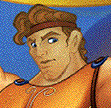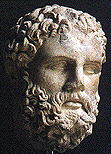|
|
|
Disney's Hercules
Hercules is the Roman name for Heracles.
|
|
Original Hercules
Hercules is the Roman name for Heracles.
|
|
|

Born immortal, became mortal
|

Born mortal, became
immortal.
|
|
|
Son of Zeus and
Hera. Born in Olympus.
The two snakes which attack the child Hercules
are two demons in disguise sent by
Hades.
|
Son of Zeus and
Alcmena, wife of
Amphitryon.
Hera, who did not
approve the love affair between
Zeus and
Alcmena, is
Heracles 1's enemy and
some say she sent the two snakes which he, being
eight months old, killed.
|
|
|
Pegasus,the winged horse that keeps
Hercules company at all times, is created by
Zeus out of a cloud.
Narcissus
appears in heaven watching himself in a mirror.
|
Pegasus, offspring of
Poseidon and
Medusa 1, is the winged
horse which opened up a spring on a mountain by
striking the rock with its hoof.
Bellerophon mounted
it when he went to kill the Chimera. It is said to
have leapt forth from the teeming neck of the slain
Medusa 1, its mane
bespattered with blood. This horse never followed
Heracles 1 in his
adventures.
Narcissus
still keeps gazing on his image in the waters of
the river Styx in the
Underworld.
|
|
|
Amphitryon and
Alcmena are adoptive
parents. They are peasants.
|
Amphitryon came to
Thebes as an exile from
Mycenae, and as a
general he ravaged the islands of the Taphians.
Amphitryon was
married with Alcmena and
during his absence in the course of one of his
military campaigns, Zeus
took his form and lay with her.
Amphitryon died in
the battlefield fighting against the
Minyans.
Alcmena is daughter of Electryon 1, King of Mycenae.
Amphitryon and Alcmena had a son
Iphicles, half brother of
Heracles 1.
|
|
|
Hades is an evil force
revolting against the established order.
|
Hades, as lord of the
Underworld, is part of the order of the world, and he is not evil, even though mortals, fearing death, often consider him a hateful god.
|
|
|
The MOERAE, who cut
the thread of life, appear sharing one eye, which
means they have been combined with the GRAEAE.
|
The MOERAE are the
three sisters who decide on human fate and cut the
thread of life. For their just way of distributing,
they are most honored by the gods, and when the
GIANTS attacked heaven
the MOERAE sided with the
OLYMPIANS.
The GRAEAE (see Perseus 1) are sisters of the GORGONS (see Medusa 1) and old women from birth. The three had but one eye and one tooth, and these they passed to each other in turn.
|
|
|
The name Penelope is used for a mule, and the
name Phidias for a potter. Philoctetes is the Satyr
who trains Hercules.
|
Penelope is the name
of Odysseus' wife.
Phidias is the name of the celebrated Athenian
sculptor from historical times, born about 490 BC.
Philoctetes
inherited the Bow and Arrows of
Heracles 1 (for these objects see Trojan
War), and with them killed Paris during the
Trojan War.
|
|
|
When Hercules meets his trainer, the Satyr
Philoctetes, also called Phil, the
ARGONAUTS have already
made their voyage long ago, and in the same way
other heroes, like
Odysseus,
Theseus,
Perseus and
Achilles, belong to the
past. The Trojan War
is presented as having already taken place.
|
Heracles 1 was a
descendant of Perseus 1, but otherwise he was an Argonaut himself. He
is a contemporary of
Theseus, and had already
left this world at the time of the
Trojan War. So both
Odysseus and
Achilles come after
him. Philoctetes,
who also fought in the
Trojan War, never
trained Heracles 1
because he was a child when
Heracles 1 died.
|
|
|
The Centaur Nessus tries to rape the until then
unknown lady in distress Megara.
|
The Centaur Nessus 2 tries to rape
Heracles 1's wife Deianira 1, while ferrying her across a river. Heracles 1 shot this centaur with his arrows, but on dying he gives a charm to Deianira 1 that in time will cause the death of Heracles 1.
|
|
|
Megara, also called Meg, is the girl Hercules
falls in love with.
She once sold her soul to evil
Hades for the good purpose
of saving her boyfriend's life. But this boyfriend
found another sweetheart, and there she is now when
Hercules meets her.
On a later occasion Megara saves Hercules.
|
Heracles 1 married
Megara, daughter of the Theban
Creon 2, who was Regent
of Thebes in more than
one occasion.
According to some Hera
drove Heracles 1 mad and he killed his wife Megara, and his children by her. But she is also said to have married Iolaus 1, charioteer of Heracles 1, at the time when
Heracles 1 had
finished his
Labours.
She did not sell her soul to
Hades, who does not buy
any.
Megara never saved
Heracles 1.
|
|
|
The Hydra is just outside
Thebes.
|
The Hydra was in Lerna,
in the Peloponnesus.
|
|
|
Hercules tells Zeus
about his submitting the
Minotaur and the Gorgon
Medusa.
|
The Minotaur was
killed by Theseus in
Crete and
Medusa 1 was beheaded by
Perseus 1.
|
|
|
Hades frees the
TITANS, so that they may
attack heaven. The TITANS
are presented as representing the four elements:
earth (as a stone monster), fire (as lava), air (as
a hurricane) and water (as lethal ice).
The scene of Hercules helping the
OLYMPIANS evokes the
fight against the GIANTS.
|
Hades is an ally of
Zeus. The
TITANS are not the same
as the four elements. According to some
Zeus liberated the
TITANS himself, and they
never revolted against him, though
Zeus became the ruler of the universe by attacking them (see Titanomachy).
The GIANTS attacked
heaven and the
OLYMPIANS were helped
by Heracles 1.
|
|
|
A Cyclops, liberated by
Hades, attacks Hercules
who, recovering his strength, fights back and
blinds his single eye.
|
The CYCLOPES were
Zeus' allies in the fight
against the TITANS. The
CYCLOPES gave the
thunderbolt to Zeus, the
trident to Poseidon and
the helmet of invisibility to
Hades.
The savage Cyclops
Polyphemus 2 was
blinded by Odysseus.
|
|
|
Hercules hurls the defeated
TITANS to outer space.
|
The defeated are usually hurled down to the
Underworld.
|
|
|
Hercules descends to the
Underworld in order
to fetch Megara's soul.
Cerberus, the three-headed dog, appears, but
does not seem to perform his duty too zealously.
Hercules' immortality becomes apparent, and
returns to the world as a triumphant
Orpheus.
|
Heracles 1 descends
to the Underworld in
order to fetch the hound of
Hades, Cerberus 1, and show it to Eurystheus, the man
who requested him to perform the
LABOURS.
Cerberus 1 guards the entrance of the Underworld.
Heracles 1 was not
immortal at the time of his descent to
Hades.
|
|
|
Hades appears to fall
into the river of the dead. Having apparently been
lynched by the populace of souls, it is doubtful
that he may ever come back, which could mean that
nobody dies any more, or that the
Underworld is left
without a lord.
|
If life comes from death and death from life, as
some say, then the destruction of the lord of the
dead would mean the annihilation of this cycle, and
the establishment of a new order.
Hades may be hateful in
the sense that death is hateful to humans, but he
is not known for ill-treating the souls of the
dead. A particular bad time in the
Underworld have those
who have offended the
OLYMPIANS.
|
|
|
Hercules renounces heaven, and stays with Megara
and his adoptive parents
Amphitryon and
Alcmena, to live the
life of a mortal.
|
Heracles 1 died as
a result of a poison, and after having burned in
the funeral pyre, he obtained immortality. Being
reconciled to Hera,
Heracles 1 married her
daughter Hebe and had
children by her in Olympus, where he stayed to live
the life of an immortal.
|